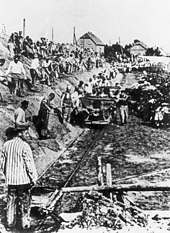Oranienburg clinker factory
The Oranienburg clinker factory was a large brick factory and a satellite camp of the Sachsenhausen concentration camp .
history
The establishment of the plant was based on an agreement between the general building inspector for the Reich capital, Albert Speer, and the administrative office of the SS in July 1938. The aim was to provide the considerable amounts of building material that Speer's plans would have needed for the transformation of Berlin into the world capital Germania . In addition to the brickworks, a separate harbor was set up at the Lehnitzschleuse and - at Speer's request - a natural stone factory. The Sachsenhausen concentration camp supplied work slaves for the construction. The operation of the large brickworks was taken over by the SS-owned Deutsche Erd- und Steinwerke .
In 1941, a few residential barracks were built, and the camp was henceforth an independent subcamp. From 1942 hand grenades were produced; the Speer work detail recycled scrap metal. From 1944 the Heinkel-Werke Oranienburg produced aircraft parts here.
The clinker work detachment was particularly feared by the inmates, as there were deaths almost daily due to exhaustion and the mistreatment of the guards.
Murder and bombing
From July to September 1942, almost all of the Rosa Winkel prisoners at the time fell here under the name of “ Aktion Klinker ” in a targeted murder campaign by the SS . The former camp elder Harry Naujoks reports in his memoirs of the murder of 200 homosexuals and “ presumptuous officers ”. Former inmate Emil Buge noted the names of 89 inmates who were murdered during the six weeks.
The murder campaign of 1942 was commemorated on June 30, 2002 and August 26, 2007 with a temporary memorial made of 200 memorial stones.
In April 1945 the US Air Force bombed the plant. Over a hundred prisoners died.
After the end of the war
After the end of the Second World War, the machines and equipment in the plant, as far as they were not destroyed, were transported to the Soviet Union. In 1948 the Red Army blew up the remaining buildings and leveled the area. In 1951 the area was handed over to the city of Oranienburg, and from 1966 to 1989 the National People's Army used it as a training area. In 1991 the site was designated as an industrial park. Among other things, a concrete company has been using the area around the port since then. Protests by former prisoners led to a halt in further business settlements in 1992. In 1996 the entire site was placed under monument protection. A year later it was decided that a history park should commemorate the earlier use of the area, and a first temporary memorial was set up at the port. Plans by the city of Oranienburg from the year 2000 envisage that a landscaping design in the historical park should remind of the former dimensions of the work. A system of paths was to be created along the previous routes. This has not happened so far, with reference to the ammunition pollution in the area. However, panels and installations at several locations on the site remind of the work.
See also
Web links
literature
- David Koser et al .: Oranienburg clinker works. In: Capital of the Holocaust. Places of National Socialist Racial Policy in Berlin. City Agency Koser, Berlin 2009, ISBN 978-3-9813154-0-0 , p. 218.
Individual evidence
- ↑ Stolperstein , from queer.de of August 3, 2017
- ↑ www.rosa-winkel.de ( Memento from March 29, 2013 in the Internet Archive )
- ↑ ( page no longer available , search in web archives: Oranienburger Generalanzeiger, July 1, 2002 ) and ( page no longer available , search in web archives: memorial event 2007 )
Coordinates: 52 ° 46 ′ 20.8 " N , 13 ° 17 ′ 1.3" E


